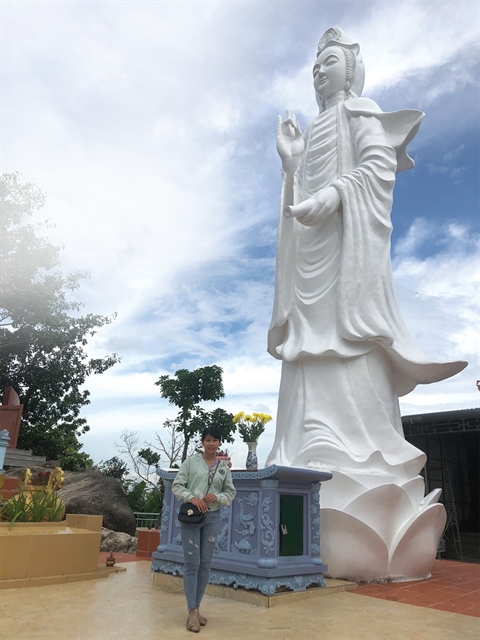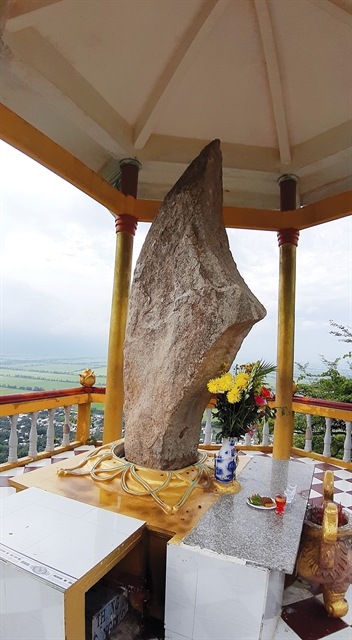[ad_1]

Phương Lan
If you want to conquer a mountain and explore local myths and exciting culture along the way, then Ba Thê Mountain in Thoại Sơn District in the southern province of An Giang is the place for you.
Located 40km from the centre of Long Xuyên City, Ba Thê Mountain is an untouched green gem amidst vast fields. It is a part of a cluster of five mountains in Thoại Sơn District, namely the Ba Thê, Nhỏ, Tượng, Trọi and Chóc mountains.
The biggest mountain in the cluster is Ba Thê at 221m above sea level and a circumference of about 4,220sq.m.
Tourists can climb up the mountain either by motorbike or on foot. I chose the first option to visit all the spiritual sites on the mountain which attract many pilgrims on holidays and during the Lunar New Year Festival.
Fortunately, a local, Quang Chính, agreed to be my tour guide. Under his guidance, I felt so excited for the journey to explore the beauty on the top of the mountain and the mysterious stories along the way.
According to Chính, Ba Thê has two peaks, commonly called Ông Tà and Tiên Sơn. It took us around 10 minutes to reach these two peaks.
The road was quite smooth with a gentle slope and a couple of continuous bends that test the skill of the drivers.
The higher we climbed, the clearer we saw the freshness that nature has bestowed on Ba Thê Mountain. The atmosphere was so cool, thanks to the endless rows of trees running up to the top, dotted with stones of various strange shapes and sizes that seemed to embellish the mystery of the mountain.
The first attraction we visited was Sơn Tiên, a small and modest pagoda towering atop Ba Thê Mountain.

The four sides of the pagoda were airy and seemed adjacent to the vast skyline. Though we were standing in the middle of the pagoda’s yard, we could still feel the wind blowing by, bringing excitement to anyone trekking into nature.
In front of the yard stands a statue of Avalokitesvara Bodhisattva, which is about 8m high. Also on the yard, there is a vestige on a high rock which is thought to be a fairy’s left foot, according to folklore. If you take a close look, you can even see the toes.
The fairy’s right foot is located a distance far away, on nearby Sập or Thoại Sơn Mountain. There is a long magical and interesting myth about the fairy feet, attracting many visitors to the sites.
On the top of Ba Thê Mountain, we could see the whole view of the stunning scene below. Lying at the foot of the mountain were pretty little houses scattered in the green immense fields, which created peaceful scenery. Many groups of visitors have fallen in love with the landscape then decided to stay overnight to enjoy the tranquillity of nature.
Descending the mountain, we paid a visit to Ông Hổ Cave that was not too far from Sơn Tiên Pagoda.
Legend has it that there was a tiger with only three legs living in the cave. Sometimes, locals came across it but it never harmed anyone.
Long after that, the mysterious tiger was not seen anymore, so locals set up an altar and carved a statue of the tiger at the cave where it used to live.
Taking another direction and driving a few hundred metres, we stopped at Đại Đao stone.

According to legend, a stone that looked like a giant sword appeared in the middle of a rainy night full of light and thunder. But it wasn’t until the next morning that the villages discovered it.
The stone was then pulled up and placed here. It was named after its shape, Đại Đao or ‘Giant Sword’. Its appearance has also attracted many curious visitors.
Our trip exploring Ba Thê Mountain ended with a visit to an exhibition house dedicated to Óc Eo Culture. Displaying many antiques and artefacts related to the ancient culture that used to exist in the area between the 2nd century BC and 12th centuries like ceramic and stone jewellery or ancient statues and bones, the house has become is a must-visited to anyone who is keen on the culture and history of the region.
There are other places of interest near Ba Thê Mountain, like Linh Sơn Pagoda, Ông Tà Peak or Chơn Thiện Cave, each of which has its own story awaiting you to come and explore. — VNS
[ad_2]
Source link
